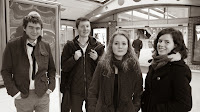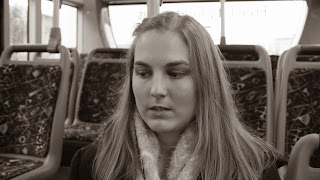As a whole I’m pretty happy with how the soundtrack came
out, the levels on the character’s lines are pretty good so that the sound of
the bus isn’t drowned out by them, yet they are strong enough to stand out even
when the chaos is at its height and there is three or four character’s speaking
at once. The overlapping voices and use of mixing left and right mono sounds really
works to create the chaotic nature we were going for, it also forces the
audience to pay more attention to one character over the others in order to
catch the glimpse of that character’s life. The editing for the sound is also
really good with the timing between the character’s line being repeated over
becoming shorter and more chaotic as the piece goes on before levelling out
again at the end. One criticism that I do have is that one or two of the
character’s lines could do with re-recording, this is mostly due to us using
friends as actors and actresses so the delivery and emotions of the lines
aren’t always delivered as good as it could be. If I was to make the project
again I would consider using people with more experience in drama or acting to deliver
the lines. For our film I think that the quality of both the photographs and
the editing was done to a high standard and I was really pleased with it. The
use of photos helps to convey the idea that what the audience is seeing is just
a snippet of that person’s life, the one criticism I would make about the
photos is that we could have done with a greater range of shots for some of the
characters. This would have add more variety to the film and could have helped
to enforce the character’s thoughts and emotions at certain points if we were
to remake the film we would definitely get more photos during the shoot to
increase the coverage and help to enforce the character’s emotions. The editing
really helped convey the idea of many different character’s stories being
glimpsed with some of the timing of the cutting even making the audience wonder
if some of the characters are linked together. In terms of criticism for the
editing I would say editing can always be improved, the timing of some cuts
could have been tighter, we could have utilised the idea of having quick
flashes of one character’s photos in the midst of another character’s thoughts
like we did earlier on in the film. There are also points in the climax where
it’s arguable if we focused on the right character or if we lost a bit of the
rhythm. This could all been improved if we spent longer editing the footage and
is something we would certainly do if we were to redo the project.
We struggled a bit for ideas for our sound project at first
and it took a while for us to really get an idea together, eventually we sat
down and discussed what work we’d seen in our seminars that we most enjoyed,
this is what sparked our idea for recording people’s thoughts on a tram. We
came up with a rough plan of what sort of sounds we wanted to record and how
they would fit together; we also decided that for the sound project I would
handle most of the recording while Chris dealt with most of the editing. Our
project went through a variety of changes when we moved from the planning stage
to the creation process, for one our original idea had been to record on a tram
but due to costs we had to move the idea to a bus, this didn’t affect our
production drastically as it only affected the atmos track and not the other content.
Another change that came about was we decided instead of asking people on the
bus what thoughts they had while on a bus we decided to script some lines for a
variety of different characters and record them in another location, this
decision was made for two reason, firstly if we recorded on the bus then there
would be a lot of background noise to deal with and secondly we thought people
wouldn’t be very inclined to divulge personal thoughts to strangers on a bus.
It wasn’t until late on in the editing that the idea of having a repeated
overlap of the character’s thoughts came around. When it came round to making
the film we didn’t really get started until the idea of having it made up
entirely of photographs that we really got started, with this idea we firstly
switched roles as Chris was more experienced at using cameras than me and so
took the bulk of the photos, we then made up a rough design of what photos we
wanted and which character’s they belonged to. We originally planned to have
some subtle moving images in our production as well but we were forced to
dismiss this idea due to the difficulty of getting steady footage on a moving
bus. The bus setting also caused other changes to our production as we had to
work with limited space and couldn’t plan for how busy the bus would be, as a
result of this we were forced to abandon the seating plan for our characters
that we had drawn up as well as some of our shots. During our shoots for the
bus photos we were forced to do some characters on different days due to our
actors being unable to make it, this limited some of the shots we could take as
we couldn’t show empty seats our different bus passengers that weren’t on the
other shots. As Chris had done the majority of the photo’s I did most of the
editing, we couldn’t really plan this section as for the most part it had to be
judged by ear which character’s voice was the most dominate or meaningful at
the time and which photos were most appropriate to follow that up with, the
editing process mostly consisted of me re-listening to the same section of
audio to distinguish which character’s photo was most appropriate and how to
follow it up with the next photo.
I would definitely say that during this project I have
developed more creatively than I have technically, because before this project
I had never even looked at audio projects or experimental films. So I had to
learn how to approach the project in an entirely different manner to how I
would normally, for instance before this project I wouldn’t think that a film
consisting purely of photograph could really express ideas or hold an
audience’s interest. As such I think I will be able to approach future briefs
in a more creative manner. On the technical side I have grown more confident
with the zoom sound recorder, a piece of equipment I had little experience
with, I’ve also learnt the benefits of specific equipment such as a pop shield
when recording just voices and a shotgun mic for recording specific sounds. For this project I also had to use Final Cut
pro an editing software that for the most part I was unsure of how to use, my
skills didn’t develop massively in this area as our project only demand me to
cut the length of the photograph although my ability in timing cuts has
developed during this project as it was an essential skill to master for this
project to work. One area where I have developed new skills with Final Cut pro
is learning about which video settings are best and what changes to make to
them before I begin any project this was caused by several exporting problems
that came about after the editing process. Chris did teach me a little about
how to use the 60D camera we booked out, so in terms of that I’ve developed in
areas such as framing shots and how to use some of the settings on the camera.
On a whole I think that Chris and I worked well as a team,
we both had strengths and weakness that counter balanced each other. For
instance during the audio part of the project Chris was the one who originally
came up with the idea of having peoples thoughts on a tram while I made the
more practical points such as cost and having to script characters, then later
when we needed to script the character’s Chris would come up with the
characters we needed and I would come up with the script. This balance continued
throughout both sections of the project and I would say contributed to the
quality of the work we produced. A strength of our teamwork would definitely be
our communication as there was never a point where one of us didn’t know what
was going on or where we were meeting, we also always made sure that both of us
were able to come at the designated time before planning a meeting so that
neither of us was left alone to do the work. Although we did take main roles in
the project such as one editor and one recorder we both contributed equally to
the recording and editing side of the project. If I was to criticise how we
worked as a team I would say that we tended to be fairly slow on actually
starting the project and we would take large breaks between working on it, this
left us rushing at times to meet crit deadlines, this could partially be put
down to us as a team not doing as much planning as we probably should have.
Personally I believe that my own teamwork skills could be improved by me
offering my ideas and criticisms more readily as I was sometimes slow or
reluctant to offer these to Chris, I did improve upon this as the project went
on but it could still do with some more work.



